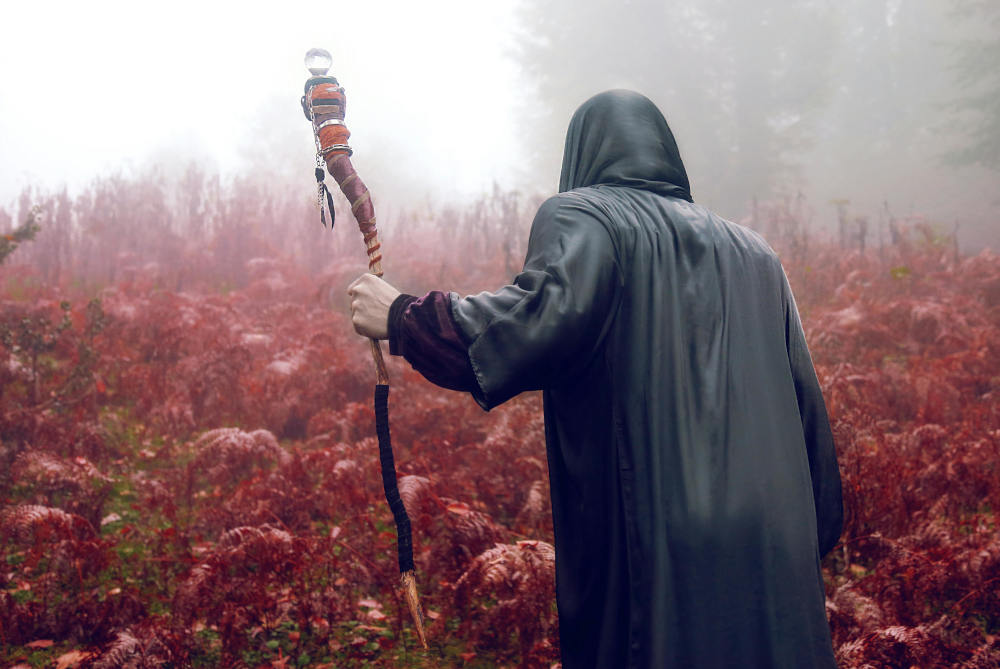
Dans la culture populaire, les termes chaman et sorcière sont souvent utilisés de manière interchangeable. Tous deux sont associés au mystique, au spirituel et aux forces invisibles de la nature. On les voit dans les films et les livres jeter des sorts, guérir et voyager dans des royaumes surnaturels. Mais chamans et sorcières sont-ils vraiment la même chose ? Ou sont-ils fondamentalement différents ?
La réponse dépend du contexte – culturel, historique et spirituel. Si chamans et sorcières partagent certaines similitudes, ils sont issus de traditions différentes, remplissent des rôles différents et sont perçus de manière très différente selon le temps et l'endroit. Découvrons ensemble la vérité derrière ces titres mystérieux.
Panaprium est indépendant et pris en charge par les lecteurs. Si vous achetez quelque chose via notre lien, nous pouvons gagner une commission. Si vous le pouvez, veuillez nous soutenir sur une base mensuelle. La mise en place prend moins d'une minute et vous aurez un impact important chaque mois. Merci!
Origines : deux chemins différents
Le mot « chaman »
Le terme chaman vient du peuple Evenk de Sibérie et a été mentionné pour la première fois par des explorateurs russes au XVIIe siècle. Il désigne un chef spirituel qui entre en transe pour communiquer avec les esprits et accéder à des connaissances cachées. Les anthropologues ont ensuite utilisé ce terme pour décrire des figures spirituelles similaires dans les cultures autochtones du monde entier, de la forêt amazonienne à la toundra arctique.
Le mot « sorcière »
Le mot « sorcière » , quant à lui, vient du vieil anglais ( wicce pour féminin, wicca pour masculin) et était historiquement associé aux personnes censées utiliser des pouvoirs surnaturels, pour le bien ou pour le mal. Ce mot a été fortement influencé par la théologie chrétienne et les procès de sorcellerie européens, où les sorcières étaient souvent accusées de pactes avec le diable.
Différence clé :
Les chamans sont principalement des guérisseurs spirituels autochtones , tandis que les sorcières étaient souvent des individus marginalisés accusés d’hérésie ou de sorcellerie dans les sociétés dominées par le christianisme.
Que font les chamans ?
Les chamans servent d' intermédiaires entre les mondes physique et spirituel . On fait souvent appel à eux pour :
-
Guérir une maladie ou un traumatisme
-
Communiquer avec les ancêtres ou les esprits
-
Guider les âmes des morts
-
Deviner l'avenir
-
Protéger la communauté des forces négatives
Les chamans pénètrent dans des états de conscience modifiés – en utilisant le tambour, le chant, la danse ou des plantes médicinales comme l'ayahuasca – pour accéder à d'autres mondes. Ils décrivent souvent des voyages vers des mondes « supérieurs » ou « inférieurs » où ils interagissent avec des alliés spirituels.
Dans les sociétés traditionnelles, les chamans sont très respectés et remplissent une fonction sacrée et communautaire .
Que font les sorcières ?
La réponse dépend de l'époque et du lieu. Historiquement, en Europe, au Moyen Âge et à la Renaissance, les sorcières étaient souvent accusées plutôt que de s'auto-identifier . Ces accusations étaient largement alimentées par la peur, les conflits religieux et le contrôle social.
Cependant, l'image moderne de la sorcière a évolué. Aujourd'hui, nombreux sont ceux qui se réapproprient le terme « sorcière » pour désigner une praticienne spirituelle ou magique qui peut :
-
Effectuer des rituels de guérison, de protection ou de manifestation
-
Honorer la nature et les cycles lunaires
-
Travailler avec des herbes, des cristaux et des symboles
-
Étudier les connaissances ésotériques ou la magie populaire
-
Suivez des traditions comme la Wicca, la sorcellerie traditionnelle ou des chemins spirituels éclectiques
Les sorcières modernes peuvent être solitaires ou faire partie de covens, et beaucoup se considèrent comme des praticiennes spirituelles terrestres , et non comme des lanceuses de sorts maléfiques.
Similitudes entre les chamans et les sorcières
Il y a une raison pour laquelle les gens confondent les deux. Les chamans et les sorcières partagent des traits communs :
-
Connexion avec la nature : tous deux travaillent en étroite collaboration avec la nature, les animaux, les plantes et les éléments.
-
Rituels et magie : Ils utilisent des symboles, des outils et des rituels sacrés pour influencer l'énergie ou la guérison.
-
États modifiés : Beaucoup pratiquent la méditation, la transe ou la cérémonie pour se connecter à d’autres royaumes.
-
Travail de guérison : les deux peuvent effectuer un travail énergétique, une guérison à base de plantes ou une purification spirituelle.
-
Autorité spirituelle : Ils sont perçus (ou craints) comme ayant accès à des connaissances et à un pouvoir cachés.
Malgré ces parallèles, leurs rôles et leurs significations culturelles divergent de manière significative.
Principales différences : contexte culturel et perception
| Aspect | Chaman | Sorcière |
|---|---|---|
| Origines | Les cultures autochtones à l'échelle mondiale | Histoire principalement européenne |
| Rôle | Guérisseur, guide spirituel, protecteur | Varié : guérisseur populaire, travailleur spirituel ou criminel accusé |
| Source spirituelle | Esprits alliés, ancêtres, guides animaux | Nature, pouvoir personnel, divinités (par exemple, dieux païens) |
| Vue dans la société | Souvent respecté, au cœur de la communauté | Souvent craint ou persécuté |
| Encadrement religieux | En dehors du christianisme, souvent animiste | Souvent jugé selon les normes chrétiennes |
| États modifiés | Transe, quêtes de vision, plantes médicinales | Parfois, mais moins central |
Les chamans ont-ils déjà été appelés sorcières ?
Oui, dans certains contextes coloniaux et missionnaires, les chamans étaient qualifiés de sorciers. Cela se produisait lorsque les explorateurs et missionnaires occidentaux découvraient des pratiques autochtones qu'ils ne comprenaient pas.
Par exemple:
-
Les missionnaires espagnols en Amérique appelaient les guérisseurs autochtones « sorciers » et « sorcières » et essayaient souvent de les convertir ou de les supprimer.
-
En Afrique, les chefs spirituels traditionnels étaient parfois accusés de sorcellerie par les colonisateurs chrétiens.
-
En Sibérie, les autorités soviétiques ont dénoncé les chamans comme des « charlatans » ou des « mystiques dangereux ».
Dans ces cas, l'étiquette de sorcière était utilisée de manière négative pour saper le pouvoir des chefs spirituels autochtones. Il s'agissait d'un outil de répression culturelle , et non d'une description précise.
Sorcellerie moderne et chamanisme d'aujourd'hui
Au cours des dernières décennies, la sorcellerie et le chamanisme ont tous deux connu un renouveau, notamment en Occident.
Sorcellerie moderne :
-
Souvent partie de chemins néopaïens comme la Wicca ou la sorcellerie éclectique.
-
Se concentre sur l’autonomisation personnelle, la divinité féminine et la magie naturelle.
-
Utilise des sorts, des rituels lunaires, des cristaux et des herbes sacrées.
Néo-chamanisme :
-
S’inspire des pratiques autochtones, parfois de manière controversée.
-
Met l’accent sur la récupération de l’âme, le voyage chamanique et la guérison des traumatismes.
-
Peut impliquer des percussions, des exercices de respiration ou des plantes médicinales (les cérémonies d'ayahuasca sont populaires).
Bien que les sorcières et les néo-chamans modernes puissent utiliser des outils similaires, leurs cosmologies et leurs objectifs spirituels peuvent être très différents.
Les chamans et les sorcières sont-ils compatibles ?
Oui, à bien des égards, c'est possible. Dans la spiritualité moderne, il n'est pas rare de trouver des personnes pratiquant des éléments des deux voies. Certaines sorcières intègrent le voyage chamanique. Certains chamans utilisent des symboles et des rituels qui s'apparentent à la magie populaire.
Les deux traditions respectent :
-
Le pouvoir de l'intention
-
Le caractère sacré de la nature
-
L'utilisation du rituel pour créer une transformation
-
Sagesse ancestrale et guérison
Il existe toutefois un inconvénient majeur : l’appropriation culturelle . Si la sorcellerie s’est largement individualisée et modernisée, le chamanisme est profondément ancré dans les cultures autochtones. Pratiquer le chamanisme sans formation adéquate ni respect du contexte culturel peut être irrespectueux, voire nuisible.
Que disent les peuples autochtones?
Pour de nombreuses communautés autochtones, le chamanisme n'est pas un loisir spirituel . C'est une vocation sacrée transmise de génération en génération, nécessitant des années de formation, d'initiation et de service communautaire.
Certains chefs autochtones s'inquiètent de l'adoption de titres ou de rituels chamaniques par des étrangers sans autorisation. Ils affirment que cela dilue ou dénature leurs traditions et qu'ils profitent souvent du savoir sacré sans rien donner en retour.
Parallèlement, la sorcellerie dans le contexte occidental moderne est souvent considérée comme une identité spirituelle personnelle , non liée à une culture ou à une lignée particulière.
Cette différence est importante. Si chacun peut explorer la spiritualité, le respect, la reconnaissance et la sensibilité culturelle sont essentiels lorsqu'on s'intéresse à des pratiques qui ne sont pas issues de son héritage.
Conclusion : les chamans sont-ils des sorcières ?
Non, les chamans ne sont pas des sorcières, mais la confusion est compréhensible.
Ils partagent des caractéristiques communes : tous deux travaillent avec les énergies spirituelles, se connectent à la nature et utilisent des rituels et des symboles pour créer la transformation. Mais leurs origines, leurs rôles et leur signification culturelle sont très différents.
-
Les chamans sont des guérisseurs sacrés et des médiateurs spirituels dans les traditions autochtones.
-
Les sorcières peuvent être des chercheuses spirituelles, des guérisseuses ou des praticiennes de la magie avec un large éventail de croyances.
Bien que les pratiques spirituelles modernes mélangent parfois les deux, il est important de se rappeler que le chamanisme est enraciné dans la culture autochtone , tandis que la sorcellerie a largement évolué dans les cadres occidentaux .
Si l'une ou l'autre voie vous attire, explorez-la avec humilité, curiosité et respect. Posez-vous les questions suivantes :
-
Est-ce que j’honore la culture derrière ces pratiques ?
-
Est-ce que je prends le temps de comprendre les traditions auxquelles j’emprunte ?
-
Est-ce que je recherche le pouvoir personnel ou une véritable connexion et un service authentique ?
En fin de compte, sorcières et chamans offrent tous deux une sagesse propice à la guérison, à la croissance et à la reconnexion au sacré. Que vous suiviez un seul chemin ou que vous combiniez les deux, empruntez-le avec intention et cœur.
Cet article vous a-t-il été utile ? S'il vous plaît dites-nous ce que vous avez aimé ou n'avez pas aimé dans les commentaires ci-dessous.
About the Author: Alex Assoune
Contre Quoi Nous Luttons
Les groupes multinationaux surproduisent des produits bon marché dans les pays les plus pauvres.
Des usines de production où les conditions s’apparentent à celles d’ateliers clandestins et qui sous-payent les travailleurs.
Des conglomérats médiatiques faisant la promotion de produits non éthiques et non durables.
De mauvais acteurs encourageant la surconsommation par un comportement inconscient.
- - - -
Heureusement, nous avons nos supporters, dont vous.
Panaprium est financé par des lecteurs comme vous qui souhaitent nous rejoindre dans notre mission visant à rendre le monde entièrement respectueux de l'environnement.
Si vous le pouvez, veuillez nous soutenir sur une base mensuelle. Cela prend moins d'une minute et vous aurez un impact important chaque mois. Merci.































0 commentaire